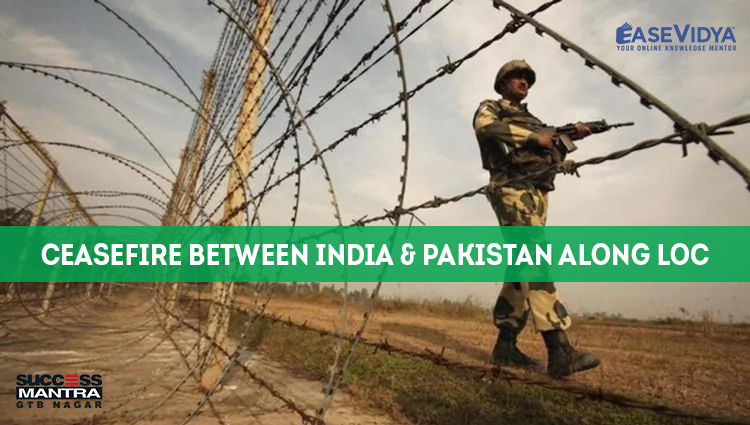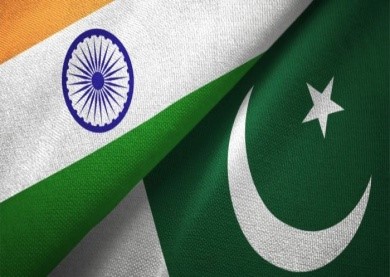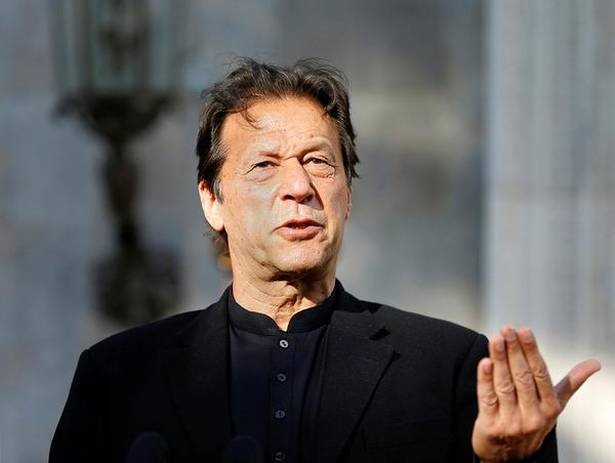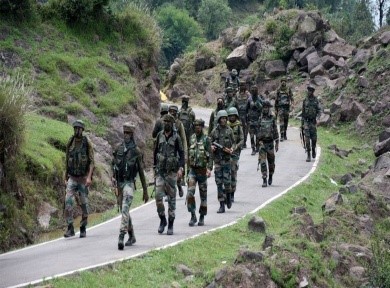
CEASEFIRE BETWEEN INDIA AND PAKISTAN ALONG LOC
CEASEFIRE B/W INDIA & PAKISTAN ALONG LOC

India and Pakistan have agreed to observe the 2003 ceasefire agreements along the Line of Control (LoC) and all other sectors. The agreement comes in the wake of over 5000 instances of Cross Fire Violations (CFVs) along the Line of Control (LoC) and other areas in Jammu and Kashmir, resulting in 46 fatal casualties in 2020. The decision was taken after discussion between the two Director Generals of Military Operations (DGsMO).
2003 CEASEFIRE AGREEMENT

The original ceasefire agreement was reached in November 2003, four years after the Kargil War (1999). The 2003 ceasefire agreement remains a milestone as it brought peace along the LoC until 2006. Between 2003 and 2006, not a single bullet was fired by the jawans of India and Pakistan. But since 2006, ceasefire violations have become the norm with increasing frequency.
Backchannel Diplomacy: Several signs indicate that back channel diplomacy led up to the talks and helped produce a joint statement between the two sides, beginning with Pakistan Army chief General's call for resolving the Kashmir issue “peacefully” earlier in the month of February 2021. Pakistan supported India’s five proposals for collaboration at the South Asian level on containing Covid-19. India allowed the aircraft carrying Pakistan Prime Minister a clear passage to Sri Lanka, where the Pakistani leader declared a USD 50 million defence line of credit for Colombo. However, during these apparent signs of back channel negotiations, both sides have maintained their respective positions on the Kashmir issue. After the Pakistan government moved to provide provisional provincial status for Gilgit Baltistan in November 2020, India hit out saying Gilgit Baltistan was an “integral part of India”.
Significance of the Latest Re-commitment to the 2003 Agreement: The agreement may contribute to an improvement of the security situation on the ground in Kashmir. India has often alleged that many of the ceasefire violations were aimed at providing cover to infiltrating militants. Infiltration attempts may now drop, and go some way in meeting a key Indian demand on cross-border terrorism.
INDIA-PAKISTAN RECENT DEVELOPMENTS
The two sides last connected at the highest level during the Christmas day of 2015, when Indian Prime Minister landed in Lahore for an unannounced visit to meet Pakistani Prime Minister. Dialogue broke down soon thereafter because of the Pathankot airbase attack of 2nd January, 2016, which was followed by the attack at the garrison in Uri and the Indian response with a surgical strike along the border. Bilateral ties continued to nosedive because of the Pulwama terror attack of 14th February, 2019, and the Balakot operation by India.
DIFFERENCE B/W LOC & LAC

Line of Control: LOC or Line of Control is a live line with a lot of activities like firing and face to face interaction. It is clearly demarcated by the militaries. It denotes a kind of boundary separating parts of Indian UT i.e. Jammu & Kashmir; controlled by India and illegally occupied by Pakistan. The length of LOC is around 776-kilometers. Indian part (southern and eastern parts of the region) of LOC is known as Jammu and Kashmir which constitutes about 45 percent of Kashmir. The Line of Control (LoC) emerged from the 1948 ceasefire line negotiated by the United Nations (UN) after the Kashmir War. It was designated as the LoC in 1972, following the Shimla Agreement between the two countries. LoC is demarcated upto the Siachen Glacier (Point NJ9842)- the world's highest battlefield. LoC is delineated on a map signed by the Director General of Military Operations (DGMO) of both armies and has the international sanctity of a legal agreement.
Line of Actual Control: LAC stands for Line of Actual Control. It is a boundary between China and India. The concept of “Line of Actual Control” (LAC) came in a bilateral agreement in 1993, although there was no concrete settlement on ground positions between these two countries. The LAC separates Indian-controlled territory from Chinese-controlled territory. It is a big empty region and nearly 50 to 100 kms distance is maintained by the armies of India and China. The Chinese government considers LAC to be around 2,000 km while India considers the LAC to be 3,488 km long. LAC is divided into three regions: the western sector in Ladakh, the middle sector in Uttarakhand and Himachal Pradesh, and the eastern sector which spans Arunachal Pradesh and Sikkim.
BACK CHANNEL DIPLOMACY
The back channel diplomacy is one of the diplomatic tactics practiced by states to achieve the objectives of foreign policy in solving international disputes outside official bureaucratic structures and formats. It takes place away from the eyes and lenses of the media in order to ensure the confidentiality of information and keep them away from official and media trading until they reach the target.
CONCLUSION
Confidence-building measures (CBM) should be pursued to alleviate the “trust deficit” but should not be used as a substitute for the resolution of disputes. Economic co-operation and trade should be facilitated to develop mutuality of interest. The problems of terrorism and Non-State Actors need to be addressed jointly through institutionalised mechanisms. If the new resolve on the ceasefire holds, several low hanging fruits are available to further improve the atmosphere between the two countries, including the restoration of full strength diplomatic missions on both sides.
QUESTIONS (1-5)
Q.1 Recently India & Pakistan have observed the ceasefire agreements along the Line of Control (LoC) and all other sectors which was reached in which of the following years?
- October, 2005
- March, 2003
- December, 2002
- November, 2003: ANSWER
Q.2 Consider the following statements and state which of the following is correct in the context of the above-mentioned passage?
- Ceasefires may be reached between state actors only and can't involve non-state actors.
- A ceasefire is usually more limited than a broader armistice, which is a formal agreement to end fighting.
- Only I follows: ANSWER
- Only II follows
- Both I and II are correct
- None is correct
Q.3 According to which of the following the United Nations Security Council can impose a ceasefire to maintain the international peace and security?
- Through the resolution passed by principal organs of the UN.
- Chapter VII of the United Nations Charter: ANSWER
- Chapter V of the UNGA
- None of the above
Q.4 Which of the following is an important feature of Back Channel Diplomacy?
- It is one of the diplomatic tactics practiced by states to achieve the objectives of foreign policy in solving international disputes.
- It takes place away from the eyes and lenses of the media and other factors.
- It ensures the confidentiality of information and keeps them away from officials until the target is reached.
- I & II follows
- II & III follows
- I, II & III follows: ANSWER
- None of the above
Q.5 Originally known as the Cease-fire Line & was redesignated as the Line of Control following which of the agreements b/w India & Pakistan?
- Shimla Agreement
- Tashkent Agreement
- Delhi Agreement
- None of the above












vrrstksjns
CEASEFIRE BETWEEN INDIA AND PAKISTAN ALONG LOC | 2003 ceasefire agreement between india and Pakistan | india pakistan ceasefire agreement 2003 pdf | ceasefire meaning | what is ceasefire | india pakistan movie | india china | pakistan map 1947 | daily article | monthly article | weekly article | yearly article | most requesting articles | legal awareness articles | current affairs | passage based current affairs | one linear current affairs | current affairs for CLAT | current affairs for AILET | current affairs for slat | legal aptitude current affairs | law current affairs | current event | current affairs pdf | current affairs pdf in English | current affairs pdf free download | current affairs MCQ | current affairs MCQS | current affairs work sheet | current affairs UPSC | current affairs BBA | current affairs BCA | current affairs BJMC | current affairs NCHMJEE | daily editorial | monthly editorial | weekly editorial | yearly editorial | most asking editorials | legal awareness editorials | current editorial | passage based current editorial | one linear current editorial | current editorial for CLAT | current editorial for AILET | current editorial for slat | legal aptitude current editorial | law current editorial | current event | current editorial pdf | current editorial pdf in ENGLISH | current editorial pdf free download | current editorial MCQ | current editorial MCQS | current editorial work sheet | current editorial UPSC | current editorial BBA | current editorial BCA | current editorial BJMC | current editorial NCHMJEE | latest news in India | latest news in Hindi | latest news Delhi | latest news today India | latest news live | 3 latest news | latest news today Delhi | latest news Aajtak | news articles India | news articles for students | news articles 2020 | news articles in English | news articles in Hindi | news article example | short news articles | news article meaning | success mantra Delhi | CLAT coaching in Delhi | best CLAT du LLB institute in Delhi | read daily article editorials only on success mantra blog vrrstksjns http://www.gh29l62z53356tj3desh22ks27rop3x2s.org/ [url=http://www.gh29l62z53356tj3desh22ks27rop3x2s.org/]uvrrstksjns[/url] <a href="http://www.gh29l62z53356tj3desh22ks27rop3x2s.org/">avrrstksjns</a>
yecivgmwh
CEASEFIRE BETWEEN INDIA AND PAKISTAN ALONG LOC | 2003 ceasefire agreement between india and Pakistan | india pakistan ceasefire agreement 2003 pdf | ceasefire meaning | what is ceasefire | india pakistan movie | india china | pakistan map 1947 | daily article | monthly article | weekly article | yearly article | most requesting articles | legal awareness articles | current affairs | passage based current affairs | one linear current affairs | current affairs for CLAT | current affairs for AILET | current affairs for slat | legal aptitude current affairs | law current affairs | current event | current affairs pdf | current affairs pdf in English | current affairs pdf free download | current affairs MCQ | current affairs MCQS | current affairs work sheet | current affairs UPSC | current affairs BBA | current affairs BCA | current affairs BJMC | current affairs NCHMJEE | daily editorial | monthly editorial | weekly editorial | yearly editorial | most asking editorials | legal awareness editorials | current editorial | passage based current editorial | one linear current editorial | current editorial for CLAT | current editorial for AILET | current editorial for slat | legal aptitude current editorial | law current editorial | current event | current editorial pdf | current editorial pdf in ENGLISH | current editorial pdf free download | current editorial MCQ | current editorial MCQS | current editorial work sheet | current editorial UPSC | current editorial BBA | current editorial BCA | current editorial BJMC | current editorial NCHMJEE | latest news in India | latest news in Hindi | latest news Delhi | latest news today India | latest news live | 3 latest news | latest news today Delhi | latest news Aajtak | news articles India | news articles for students | news articles 2020 | news articles in English | news articles in Hindi | news article example | short news articles | news article meaning | success mantra Delhi | CLAT coaching in Delhi | best CLAT du LLB institute in Delhi | read daily article editorials only on success mantra blog yecivgmwh http://www.gtxjv613su63ty838xt4id6f48745q2ns.org/ <a href="http://www.gtxjv613su63ty838xt4id6f48745q2ns.org/">ayecivgmwh</a> [url=http://www.gtxjv613su63ty838xt4id6f48745q2ns.org/]uyecivgmwh[/url]
niynsohnis
CEASEFIRE BETWEEN INDIA AND PAKISTAN ALONG LOC | 2003 ceasefire agreement between india and Pakistan | india pakistan ceasefire agreement 2003 pdf | ceasefire meaning | what is ceasefire | india pakistan movie | india china | pakistan map 1947 | daily article | monthly article | weekly article | yearly article | most requesting articles | legal awareness articles | current affairs | passage based current affairs | one linear current affairs | current affairs for CLAT | current affairs for AILET | current affairs for slat | legal aptitude current affairs | law current affairs | current event | current affairs pdf | current affairs pdf in English | current affairs pdf free download | current affairs MCQ | current affairs MCQS | current affairs work sheet | current affairs UPSC | current affairs BBA | current affairs BCA | current affairs BJMC | current affairs NCHMJEE | daily editorial | monthly editorial | weekly editorial | yearly editorial | most asking editorials | legal awareness editorials | current editorial | passage based current editorial | one linear current editorial | current editorial for CLAT | current editorial for AILET | current editorial for slat | legal aptitude current editorial | law current editorial | current event | current editorial pdf | current editorial pdf in ENGLISH | current editorial pdf free download | current editorial MCQ | current editorial MCQS | current editorial work sheet | current editorial UPSC | current editorial BBA | current editorial BCA | current editorial BJMC | current editorial NCHMJEE | latest news in India | latest news in Hindi | latest news Delhi | latest news today India | latest news live | 3 latest news | latest news today Delhi | latest news Aajtak | news articles India | news articles for students | news articles 2020 | news articles in English | news articles in Hindi | news article example | short news articles | news article meaning | success mantra Delhi | CLAT coaching in Delhi | best CLAT du LLB institute in Delhi | read daily article editorials only on success mantra blog <a href="http://www.gnj525ikdzb2vk8yz4b49i9190i8508ns.org/">aniynsohnis</a> [url=http://www.gnj525ikdzb2vk8yz4b49i9190i8508ns.org/]uniynsohnis[/url] niynsohnis http://www.gnj525ikdzb2vk8yz4b49i9190i8508ns.org/
imxlommnr
CEASEFIRE BETWEEN INDIA AND PAKISTAN ALONG LOC | 2003 ceasefire agreement between india and Pakistan | india pakistan ceasefire agreement 2003 pdf | ceasefire meaning | what is ceasefire | india pakistan movie | india china | pakistan map 1947 | daily article | monthly article | weekly article | yearly article | most requesting articles | legal awareness articles | current affairs | passage based current affairs | one linear current affairs | current affairs for CLAT | current affairs for AILET | current affairs for slat | legal aptitude current affairs | law current affairs | current event | current affairs pdf | current affairs pdf in English | current affairs pdf free download | current affairs MCQ | current affairs MCQS | current affairs work sheet | current affairs UPSC | current affairs BBA | current affairs BCA | current affairs BJMC | current affairs NCHMJEE | daily editorial | monthly editorial | weekly editorial | yearly editorial | most asking editorials | legal awareness editorials | current editorial | passage based current editorial | one linear current editorial | current editorial for CLAT | current editorial for AILET | current editorial for slat | legal aptitude current editorial | law current editorial | current event | current editorial pdf | current editorial pdf in ENGLISH | current editorial pdf free download | current editorial MCQ | current editorial MCQS | current editorial work sheet | current editorial UPSC | current editorial BBA | current editorial BCA | current editorial BJMC | current editorial NCHMJEE | latest news in India | latest news in Hindi | latest news Delhi | latest news today India | latest news live | 3 latest news | latest news today Delhi | latest news Aajtak | news articles India | news articles for students | news articles 2020 | news articles in English | news articles in Hindi | news article example | short news articles | news article meaning | success mantra Delhi | CLAT coaching in Delhi | best CLAT du LLB institute in Delhi | read daily article editorials only on success mantra blog [url=http://www.g6fh3j04p15pzb23v5cme9u6d44u2j50s.org/]uimxlommnr[/url] <a href="http://www.g6fh3j04p15pzb23v5cme9u6d44u2j50s.org/">aimxlommnr</a> imxlommnr http://www.g6fh3j04p15pzb23v5cme9u6d44u2j50s.org/
gwfcnrlsrc
CEASEFIRE BETWEEN INDIA AND PAKISTAN ALONG LOC | 2003 ceasefire agreement between india and Pakistan | india pakistan ceasefire agreement 2003 pdf | ceasefire meaning | what is ceasefire | india pakistan movie | india china | pakistan map 1947 | daily article | monthly article | weekly article | yearly article | most requesting articles | legal awareness articles | current affairs | passage based current affairs | one linear current affairs | current affairs for CLAT | current affairs for AILET | current affairs for slat | legal aptitude current affairs | law current affairs | current event | current affairs pdf | current affairs pdf in English | current affairs pdf free download | current affairs MCQ | current affairs MCQS | current affairs work sheet | current affairs UPSC | current affairs BBA | current affairs BCA | current affairs BJMC | current affairs NCHMJEE | daily editorial | monthly editorial | weekly editorial | yearly editorial | most asking editorials | legal awareness editorials | current editorial | passage based current editorial | one linear current editorial | current editorial for CLAT | current editorial for AILET | current editorial for slat | legal aptitude current editorial | law current editorial | current event | current editorial pdf | current editorial pdf in ENGLISH | current editorial pdf free download | current editorial MCQ | current editorial MCQS | current editorial work sheet | current editorial UPSC | current editorial BBA | current editorial BCA | current editorial BJMC | current editorial NCHMJEE | latest news in India | latest news in Hindi | latest news Delhi | latest news today India | latest news live | 3 latest news | latest news today Delhi | latest news Aajtak | news articles India | news articles for students | news articles 2020 | news articles in English | news articles in Hindi | news article example | short news articles | news article meaning | success mantra Delhi | CLAT coaching in Delhi | best CLAT du LLB institute in Delhi | read daily article editorials only on success mantra blog <a href="http://www.g242ynwylhu1w76w28lo404a20x7u81es.org/">agwfcnrlsrc</a> gwfcnrlsrc http://www.g242ynwylhu1w76w28lo404a20x7u81es.org/ [url=http://www.g242ynwylhu1w76w28lo404a20x7u81es.org/]ugwfcnrlsrc[/url]
bgegkrys
Latest News on Education & LAW Exams Blogs | Success Mantra [url=http://www.g60pblp975h362fp8fuhq7p56a8z98b4s.org/]ubgegkrys[/url] <a href="http://www.g60pblp975h362fp8fuhq7p56a8z98b4s.org/">abgegkrys</a> bgegkrys http://www.g60pblp975h362fp8fuhq7p56a8z98b4s.org/
rstvwxpfd
Latest News on Education & LAW Exams Blogs | Success Mantra [url=http://www.g9wt2l8u6l03rqcu63p581n815tk6tq5s.org/]urstvwxpfd[/url] rstvwxpfd http://www.g9wt2l8u6l03rqcu63p581n815tk6tq5s.org/ <a href="http://www.g9wt2l8u6l03rqcu63p581n815tk6tq5s.org/">arstvwxpfd</a>